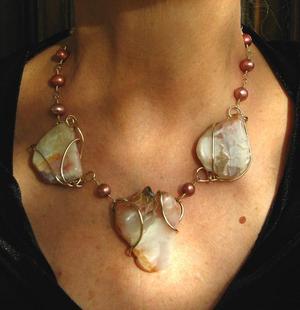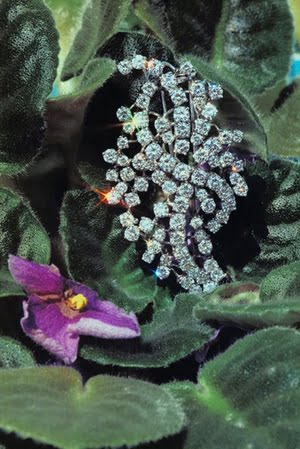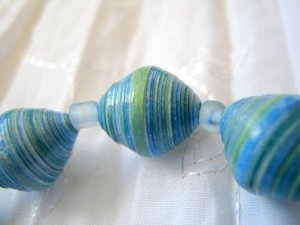If I asked you what your favorite gemstone is, petrified wood would not be your answer. It would be mine. Pieces of petrified wood are set as gemstones in designer jewelry, as they are in my most boldly elegant designs. Let me explain why petrified wood is becoming so popular in contemporary handcrafted jewelry in the Southwest.
Petrified wood is not wood any more
They began as trees and ended up rock, heavy and hard and quite unlike the big green growths we see in our forests today. Petrified wood is the fossilized form of trees that grew in primeval forests. The petrified wood found today in the desert northeastern parts of Arizona are trees from the Triassic Period, growing back then anywhere from 180 to 220 million years ago. Petrified wood is found also in places around the world, including Madagascar, which is the largest commercial producer of petrified wood that is mostly brownish in color. More about the colors of petrified wood in a moment.
No air
Petrified wood is found today in places where the conditions were right for the transformation of trees into stone. The required condition is an anaerobic environment. Trees seed, they sprout, they grow, and they fall over and die. When they do so in watery surrounds such as streams, rivers, or shallow seas and are covered over in silt, mud, or sediment, the conditions are right for driving out the oxygen that would decay the tree rather than petrify it. Most dead trees decay in time. But the relative few that we find today in fossilized form are the ones that were covered over quickly enough to avoid the degenerative oxidation process we know as decay and instead were preserved by the process of petrification.
Petrification actually does not take that long, relatively speaking. One hundred years or so are required for the tree to turn to stone. And it does so by the slow flow of mineral laden waters through the internal infrastructure of the tree. Silicates replace soft cellular organic material, solidifying as a quartz and leaving the tree to look much like a tree except that now it is stone. Whenever that one hundred years happened, it was undoubtedly still many millions of years ago and before the Colorado plateau rose up to the more than mile high elevation it stands at today. Erosion of southwestern lands on the plateau wore away the ground around the preserved trees and exposed the fallen, now petrified, trees as we find them today. We find them today embedded in or lying on the ground looking like somebody took a chain saw and cut them into segments. But there were no human beings around, nevermind chain saws, when the trees broke into pieces. That occurred naturally.
So now we have large, log-like protrusions jutting out from grounds of the high desert plateau. They look like the timberman’s harvest, cut and ready for loading and transport to market. They’re not; petrification has transformed them to gemstone. You can observe them in their natural solidified state in the state of Arizona, in Holbrook at the Petrified Forest National Park. You can observe and sample smaller pieces in the rock shops along Interstate 40 in the area. My favorite is a dusty one with an old Edsel in the parking lot just off Exit 301. Called “the rock factory,” it’s a sleepy highway outlet for rocks of all kinds from C and E Rock Sales, of St. Johns, Arizona.
Gemstone Colors
What makes this place my favorite rock shop is the variety of semi-precious stones and petrified wood. What makes this place my husband’s favorite is the Edsel. (And, no, it’s not running, although they sometimes push it across the lot to impart a new perspective on the rock shop.) For both of us, the friendly lady behind the counter is our favorite rock saleslady, who never remembers me until I ask her to show me the special pieces of petrified wood secreted away in the back room. She does the retail sales from this shop; the St. Johns shop is where they do the cutting, grinding, tumbling, and polishing of the petrified wood, which starts out as a large rock the size of a tree trunk, which, of course, it used to be.
Only in this particular place can I find the largest, most delicately colored, polished pieces of petrified wood. The lightest white specimens are the areas of the wood that were petrified by pure silicates. The quartz has little or no color; what there is, if any at all, is a pale pastel. Such specimens are featured in gold wire wrap jewelry designs that finish nicely with pastel colored pearls. Some specimens have an intense orange color, which arises from impurities of manganese in the petrifying fluids. An incredible red color appears in veins or admixture with other colors from iron oxide impurities. A specimen of solid blood red petrified wood in the shape of a heart was the basis of an entire neckpiece design line called “The Heart Forever Necklace.” Jewelry designs in petrified wood in that shape and that color were an immediate attraction to women having the slightest connection to matters of the heart. That’s every lady out there. The line was a winner. And that’s because of all the incredible colors in which petrified wood comes to us.
So, you may not think of petrified wood as a gemstone. But find a beautiful piece and you may change your mind. Design that piece into a piece of designer jewelry and the transformation is complete. From trees to rock, from degradation to preservation, from ancient silty swamps arise gemstone from dry land in the shape of a fallen tree.




